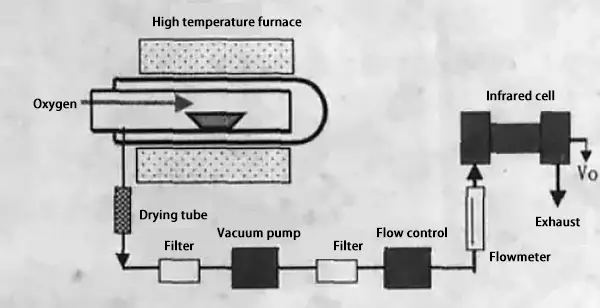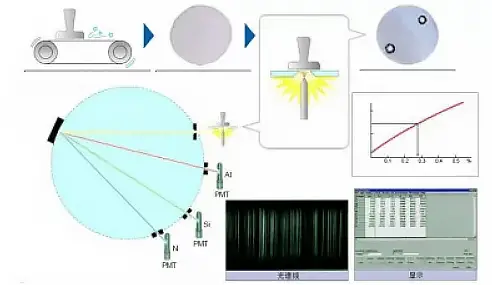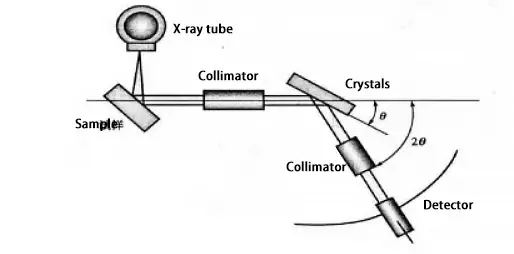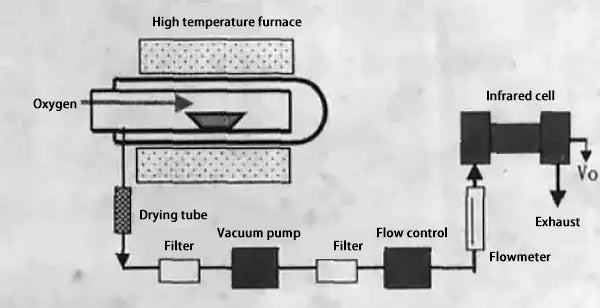The development and use of metals and their composite materials often require precise control and precise determination of their carbon and sulfur content.
Carbon in metallic materials mainly exists in the form of free carbon, solid solution carbon, composite carbon, gaseous carbon, surface protective carburization and coated organic carbon.
Currently, methods for analyzing carbon content in metals include combustion, emission spectrometry, gas volumetrics, non-aqueous titration, infrared absorption and chromatography, among others.
However, each measurement method has a limited scope of application, and the measurement results may be affected by various factors, such as the shape of the carbon, whether it can be completely released during oxidation, and the blank value. Thus, the same method can produce different levels of accuracy in different situations.
This article summarizes current analysis methods, sample preparation, instruments and fields of application for carbon analysis in metals.
1. Infrared absorption method
The combustion infrared absorption method, which is based on the infrared absorption method, is a specialized method for the quantitative analysis of carbon (and sulfur).
The principle behind this method involves burning the sample in a stream of oxygen to produce CO2.
At a specific pressure, the energy absorbed by CO2 from infrared rays is proportional to its concentration.
Therefore, the carbon content can be calculated by measuring the change in energy before and after the CO2 gas passes through the infrared absorber.

Principle of combustion infrared absorption method
In recent years, infrared gas analysis technology has advanced rapidly, leading to the rapid emergence of various analytical instruments based on the principles of high-frequency induction heating, combustion and absorption of the infrared spectrum.
When determining the carbon and sulfur content using the high-frequency combustion infrared absorption method, the following factors should generally be taken into consideration: sample dryness, electromagnetic sensitivity, geometric size, sample size, flow type, aspect ratio, addition order, addition quantity, blank value settings, etc.
This method has the advantage of providing accurate quantification with minimal interference.
It is suitable for users who place great emphasis on carbon content accuracy and have sufficient time for testing during production.
2. Emission spectroscopy
When an element is energized by heat or electricity, it transitions from its ground state to an excited state, which will then spontaneously return to the ground state.
During the process of returning from the excited state to the ground state, each element releases its characteristic spectrum, and its content can be determined based on the intensity of this spectrum.

Emission Spectrometer Principle
In the metallurgical industry, where production demands are high, it is necessary to quickly analyze the content of all major elements in furnace water, not just carbon.
Spark direct reading emission spectrometers have become the preferred choice in this industry due to their ability to provide fast and stable results.
However, this method has specific requirements for sample preparation.
For example, when analyzing cast iron samples by spark spectroscopy, it is necessary that the carbon on the surface of the sample is in the form of carbides and free of graphite, otherwise the analysis results may be affected.
Some users take advantage of the rapid cooling and bleaching properties of thin slices to determine the carbon content in castings by spark spectroscopy after turning the samples into slices.
When using spark spectroscopy to analyze carbon steel wire samples, the samples must be processed rigorously and placed “upright” or “flat” on the spark table for analysis using a small sample analysis device in order to improve accuracy. of the analysis.
3. Wavelength Dispersive X-ray Method
The wavelength dispersive X-ray analyzer can quickly and simultaneously determine the content of multiple elements.

Principle of Wavelength Dispersive X-ray Fluorescence Spectrometer
The wavelength dispersive X-ray fluorescence spectrometer (WDXRF) uses X-ray excitation to cause the inner electrons of element atoms to transition in energy level and emit secondary X-rays, also known as X-ray fluorescence X.
The spectrometer splits the light using a crystal and the detector detects the characteristic diffracted X-ray signal.
By synchronizing and continuously changing the diffraction angle of the spectroscopic crystal and the controller, the characteristic wavelength of X-rays and the intensity of each wavelength X-ray produced by various elements in the sample can be obtained for qualitative and quantitative analysis.
First produced in the 1950s, WDXRF has been widely used in the geology department due to its ability to simultaneously determine multiple components in complex systems, leading to greater speed of analysis.
However, the low fluorescence yield of the light element carbon and the significant absorption and attenuation of its characteristic radiation by heavy matrix materials such as steel present challenges in the XRF analysis of carbon.
Repeated measurements of the soil surface can also result in increased carbon content values. As a result, this method is not as widely used as the previous two methods mentioned.
4. Non-aqueous titration method
The non-aqueous titration method is a titration method that uses a non-aqueous solvent. This method allows the titration of weak acids and bases that cannot be titrated in aqueous solution by selecting an appropriate solvent to increase their acidity or alkalinity.
For example, the weakly acidic carbonic acid generated by CO2 in water can be accurately titrated using different organic reagents.
The commonly used non-aqueous titration method includes the following steps:
- The sample is burned at high temperature in an electric arc furnace equipped with a carbon and sulfur analyzer.
- The carbon dioxide gas emitted by combustion is absorbed by the ethanol-ethanolamine solution and reacts with ethanolamine to form a relatively stable 2-hydroxyethylamine carboxylic acid.
- KOH is used for non-aqueous titration.
This method is toxic, long-term exposure can affect human health, and is difficult to operate, especially when the carbon content is high and the solution must be predefined. Any carelessness can cause low results due to carbon exhaust.
In addition, the reagents used in the non-aqueous titration method are mostly flammable products, and high-temperature heating operations are involved in the experiment, therefore, operators must have a strong safety awareness.
5. Chromatography
The flame atomization detector is used in conjunction with gas chromatography to heat the sample into hydrogen and then detect the emitted gases such as CH4 and CO using the flame atomization-gas chromatography detector.
This method is ideal for those who have an extremely low carbon content and high requirements for test results. For example, some users have used this method to test trace amounts of carbon in high-purity iron with a content of 4 µg/g and an analysis time of 50 minutes.
6. Electrochemical methods
Some users have introduced the use of potentiometric analysis to determine low carbon content in alloys.
After the iron sample is oxidized in an induction furnace, an electrochemical concentration cell based on potassium carbonate solid electrolyte is used to analyze and determine the gaseous product to determine the carbon concentration.
This method is especially suitable for the determination of very low carbon concentrations. The accuracy and sensitivity of the analysis can be controlled by adjusting the reference gas composition and the sample oxidation rate.
However, this method has limited practical applications and remains mainly in the experimental research phase.
7. Online analysis method
When refining steel, it is often necessary to monitor the carbon content of molten steel in real time in a vacuum furnace.
Some scholars in the metallurgical industry have introduced methods of using waste gas information to estimate carbon concentration.
Using oxygen consumption and concentration during the vacuum decarburization process, along with oxygen and argon flow rates, they estimate the carbon content in the molten steel.
Furthermore, some users have developed methods and instruments for rapid determination of carbon traces in molten steel. By blowing a carrier gas into the molten steel, they estimate the carbon content by measuring the oxidized carbon in the carrier gas.
These online analysis methods are useful for quality management and performance control in the steel production process.

























































